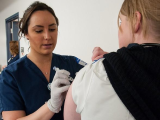Oct 3, 2011 (CIDRAP News) – A run of stability in the makeup of seasonal influenza vaccines continued as the World Health Organization (WHO) recently recommended using the same three flu strains in next year's Southern Hemisphere vaccine as are in the current Northern Hemisphere vaccine and were used last year in southern countries.
The recommendation means the WHO has seen little evidence of changes in circulating flu strains that would make the vaccines now in use a poor match for them.
The WHO experts recommended keeping the pandemic 2009 strain for the influenza A/H1N1 component of the vaccine, along with a Perth 2009 strain of A/H3N2 and a Brisbane 2008 strain of influenza B. Officially, the agency advises using strains similar to:
- A/California/7/2009(H1N1)pdm09
- A/Perth/16/2009 (H3N2)
- B/Brisbane/60/2008
The new recommendation means the WHO has chosen the same three strains for the Southern Hemisphere 3 years in a row, as the agency first picked them in September 2009 for the 2010 season. That was when the WHO first chose the pandemic 2009 H1N1 strain for the vaccine on the expectation—which proved correct—that it would replace the previous seasonal H1N1 strain.
The WHO's experts make their recommendations for the makeup of Southern Hemisphere flu vaccines in September to allow time to prepare the vaccine viruses and grow them in eggs, which takes several months. The recommendation for the Northern Hemisphere is usually made in February.
The WHO's technical report says 2009 H1N1 viruses co-circulated in varying proportions with H3N2 and type B viruses from February to September of this year, with widespread activity in many countries. But compared with previous years, activity was generally "low or moderate." No isolates of the previous seasonal H1N1 vaccine were found.
The circulating 2009 H1N1 viruses have remained antigenically and genetically similar to the California strain in the current vaccine, the report says. Likewise, the majority of recent H3N2 isolates have been similar to the Perth strain in the vaccine.
Influenza B comes in two lineages, Victoria and Yamagata, and predicting which will predominate in any given season has been difficult. The Brisbane 2008 strain in current vaccines is a Victoria strain. The WHO says Victoria strains have predominated recently in many parts of the world and have been closely related to the vaccine strain, but Yamagata variants were more common in northern China from February to May.
In a note on drug resistance, the WHO says the vast majority of 2009 H1N1 viruses have remained sensitive to oseltamivir (Tamiflu). Of the resistant isolates, most were associated with use of the drug for prevention or treatment. But in the United States, the United Kingdom, and Japan, "there were increased proportions of resistant cases with no known exposure to oseltamivir."
The report also notes that 45 human infections with the H5N1 avian influenza virus were reported from Feb 16 to Sep 19 of this year, including 24 deaths. The cases occurred in Bangladesh, Cambodia, Egypt, and Indonesia, where the virus circulates in poultry. The cumulative global H5N1 count is 564 cases with 330 deaths.
The same period also brought one human case of H9N2 flu in Bangladesh and four human infections with swine H3N2 viruses in the United States, the WHO said.
See also:
September 2011 WHO report on flu vaccine recommendations for the Southern Hemisphere
Feb 17 CIDRAP News story on WHO vaccine recommendations for 2011-12 Northern Hemisphere flu vaccine
Feb 18, 2010, CIDRAP News story on WHO vaccine recommendations for 2010-11 Northern Hemisphere vaccine
Sep 23, 2009, CIDRAP News story on WHO recommendations for 2010 Southern Hemisphere vaccine




















